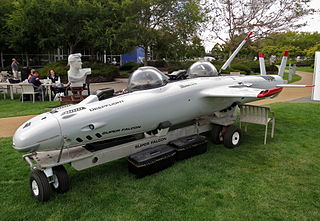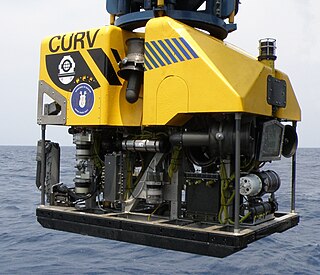
A remotely operated underwater vehicle (ROUV) or remotely operated vehicle (ROV) is a free-swimming submersible craft used to perform underwater observation, inspection and physical tasks such as valve operations, hydraulic functions and other general tasks within the subsea oil and gas industry, military, scientific and other applications. ROVs can also carry tooling packages for undertaking specific tasks such as pull-in and connection of flexible flowlines and umbilicals, and component replacement.

A submersible is an underwater vehicle which needs to be transported and supported by a larger watercraft or platform. This distinguishes submersibles from submarines, which are self-supporting and capable of prolonged independent operation at sea.

A deep-submergence vehicle (DSV) is a deep-diving crewed submersible that is self-propelled. Several navies operate vehicles that can be accurately described as DSVs. DSVs are commonly divided into two types: research DSVs, which are used for exploration and surveying, and DSRVs, which are intended to be used for rescuing the crew of a sunken navy submarine, clandestine (espionage) missions, or both. DSRVs are equipped with docking chambers to allow personnel ingress and egress via a manhole.

An atmospheric diving suit (ADS) is a small one-person articulated submersible which resembles a suit of armour, with elaborate pressure joints to allow articulation while maintaining an internal pressure of one atmosphere. An ADS can enable diving at depths of up to 700 metres (2,300 ft) for many hours by eliminating the majority of significant physiological dangers associated with deep diving. The occupant of an ADS does not need to decompress, and there is no need for special breathing gas mixtures, so there is little danger of decompression sickness or nitrogen narcosis when the ADS is functioning properly. An ADS can permit less skilled swimmers to complete deep dives, albeit at the expense of dexterity.

Kaikō was a remotely operated underwater vehicle (ROV) built by the Japan Agency for Marine-Earth Science and Technology (JAMSTEC) for exploration of the deep sea. Kaikō was the second of only five vessels ever to reach the bottom of the Challenger Deep, as of 2019. Between 1995 and 2003, this 10.6 ton unmanned submersible conducted more than 250 dives, collecting 350 biological species, some of which could prove to be useful in medical and industrial applications. On 29 May 2003, Kaikō was lost at sea off the coast of Shikoku Island during Typhoon Chan-Hom, when a secondary cable connecting it to its launcher at the ocean surface broke.
The Priz class is a type of deep-submergence rescue vehicle (DSRV) operated by the government of Russia. There are known to be at least five vessels of the class, several of which were involved in the failed rescue attempt when the submarine Kursk sank on 12 August 2000. The Russian word "Priz" (“приз”) means "prize".

AS-28 is a Priz-class deep-submergence rescue vehicle of the Russian Navy, which entered service in 1986. It was designed for submarine rescue operations by the Lazurit Design Bureau in Nizhny Novgorod. It is 13.5 m (44 ft) long, 5.7 m (19 ft) high, and can operate up to a depth of 1,000 m (3,300 ft).

The Scorpio is a brand of underwater submersible Remotely Operated Vehicle (ROV) manufactured by Perry Tritech used by sub-sea industries such as the oil industry for general operations, and by the Royal Navy and the United States Navy for submarine rescue services. Originally developed by AMETEK Straza of El Cajon, United States, they were subsequently developed by Perry Tritech. Although the design of the original Scorpio is over several decades old, it forms the basis for a current generation of Scorpio-branded ROVs. Scorpio ROVs are named in a sequence following the order of manufacture, such as "Scorpio 17" or "Scorpio 45" which refer to specific ROVs.

The LR5 is a crewed submersible which was used by the British Royal Navy until 2009 when it was leased to support the Royal Australian Navy. It is designed for retrieving sailors from stranded submarines and is capable of rescuing 16 at a time. The Royal Navy now has the use of the NATO Submarine Rescue System.

A deep-submergence rescue vehicle (DSRV) is a type of deep-submergence vehicle used for rescue of downed submarines and clandestine missions. While DSRV is the term most often used by the United States Navy, other nations have different designations for their vehicles.
ROPOS is an ROV used primarily for scientific research. It was originally built in Vancouver by International Submarine Engineering and purchased by the Canadian federal government. The same government program also operated the Pisces IV crewed submersible, now in Hawaii being run by the Hawai'i Undersea Research Laboratory (HURL) who found the long-lost two-man Japanese sub which heralded the attack on Pearl Harbor.
The Chinese 8A4 class ROUV is a remotely operated underwater vehicle (ROUV) used to perform various underwater tasks, ranging from oil platform service to salvage and rescue missions. The 8A4 is a member of a series of related ROUVs developed by the Shenyang Institute of Automation (SIA) in the People's Republic of China (PRC). The predecessor to the 8A4 was the RECON-IV, an improved version of the American RECON-III. The 8A4 itself is an upgraded version of the American AMETEK 2006, and the 7B8 is an improved version of the 8A4.
SJT-class ROUVs are a series of Chinese remotely operated underwater vehicles (ROUVs) jointly developed by the Shenyang Institute of Automation of the Chinese Academy of Science and the Institute of Underwater Engineering of Shanghai Jiao Tong University (SHJTU). The general designer of the SJT-class of ROUVs is Zhu Jimao (朱继懋), a professor at SHJTU, who also was the general designer of the earlier Type 7103 DSRV. Many more ROUVs have been developed after the SJT series, based on experience gained from this series.

The Cheonghaejin class is a submarine rescue ship class of the Republic of Korea Navy. Only one ship has been built in the class, ROKS Cheonghaejin, in 1995. Its operations include rescuing trapped sailors in submarines, naval operation support for submarines, underwater research and mapping support, and recovery of sunk vessels. It is equipped with a deep submergence rescue vehicle (DSRV) that operates up to 500 metres (1,600 ft), and a rescue chamber that holds up to nine people.

The DeepFlight Super Falcon is a personal submarine designed by Graham Hawkes, a former civilian ocean engineer. It was hoped that the technology used in this submersible would allow travel to the deepest parts of the ocean.
ABISMO is a remotely operated underwater vehicle (ROV) built by the Japan Agency for Marine-Earth Science and Technology (JAMSTEC) for exploration of the deep sea. It is the only remaining ROV rated to 11,000-meters, ABISMO is intended to be the permanent replacement for Kaikō, a ROV that was lost at sea in 2003.

ROKS Gwangyang (ATS-32) is the second ship of the Tongyeong-class salvage and rescue ship in the Republic of Korea Navy. She is named after the city, Gwangyang.
Submarine rescue is the process of locating a sunk submarine with survivors on board, and bringing the survivors to safety. This may be done by recovering the vessel to the surface first, or by transferring the trapped personnel to a rescue bell or deep-submergence rescue vehicle to bring them to the surface. Submarine rescue may be done at pressures between ambient at depth, and sea level atmospheric pressure, depending on the condition of the distressed vessel and the equipment used for the rescue. Self-rescue of submarine personnel by buoyant free ascent at ambient pressure is considered submarine escape. Survivors may require recompression treatment for decompression illness.

CURV-21 is a remotely operated underwater vehicles (ROV) of the United States Navy designed to meet its deep ocean salvage requirements down to a maximum depth of 20,000 feet (6,100 m) of seawater.

ROVOdysseus 6K is a remotely operated underwater vehicle designed and operated by Pelagic Research Services of South Wellfleet, Massachusetts. The ROV is named for Odysseus, protagonist of the Odyssey, and its maximum rated depth, 6,000 m (20,000 ft), measured as metre sea water.














